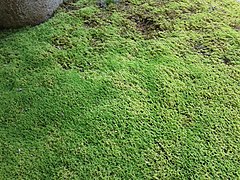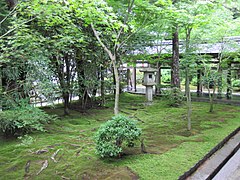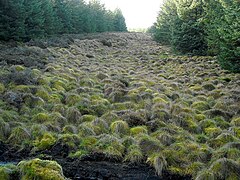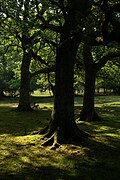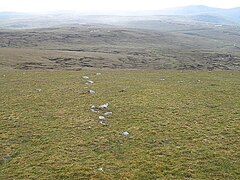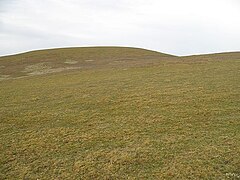Talk:Moss lawn
| This article is rated C-class on Wikipedia's content assessment scale. It is of interest to the following WikiProjects: | |||||||||||||||||||||
| |||||||||||||||||||||
Some sources
[edit]Hi, User:Clovermoss! I'm moving this discussion here from my talk page as others might be interested. Is the book:
- Martin, Annie (2015-09-09). The magical world of moss gardening. Timber Press, Incorporated. ISBN 9781604695601., 240 pages? (the Goodreads reviews are entertaining)
- Schenk, George (February 1997). Moss gardening : including lichens, liverworts, and other miniatures. Timber Press. ISBN 9780881923704., 262 pages
- Nordstroem, Ulrica (March 2019). Moss : from forest to garden: a guide to the hidden world of moss. Penguin Books Ltd. ISBN 9780241374474., 192 pages, non-illustrated?
I don't have access to the notes I mentioned just now, but I remember this one particularly:
- Mossandstonegardens was a quirky and informative site, still available on the Wayback Machines. how-to; misc educational
The rest of this is more of an infodump than notes; I hope you will ignore anything that does not look interesting. 苔, koke, is "moss" in Japanese, a useful search term. 庭, niwa, is "garden". I've added a fair number of mossy gardens in the commons category. Most are Japanese. This may be an artifact of how people label things.
-
Somewhere in Gora, Hakone
-
Saihō-ji
-
Green under snow at Nezu Museum
-
Sekirakuen, the garden of the Hakone Art Museum
-
Ginkaku-ji
-
Toshodai-ji (apparently frosty)
-
Somewhere in Japan!
There are also a lot of sources on naturally-occurring moss lawns. These seem to pop up under conifers at elevation or at high latitudes; north of the treeline, the conifers are gone, but the moss keeps going; glaciers come, and the moss chills for a few centuries and then keeps going once it thaws. Canada seems to have a lot of moss research. Tropical moss seems more likely to grow on trees, not as groundcover.
- Naturally-occurring moss lawns
-
Moss and grass hummocks
-
Deciduous
-
Deciduous
-
Deciduous
-
High-altitude
-
Same
-
Climate...
-
Moss in melting snow
A lot of the peer-reviewed lit is probably pretty offtopic for this article, but on the offchance you're interested I'll post it.
- Turetsky, Merritt R.; Mack, Michelle C.; Hollingsworth, Teresa N.; Harden, Jennifer W. (July 2010). "The role of mosses in ecosystem succession and function in Alaska's boreal forest". Canadian Journal of Forest Research. This article is one of a selection of papers from The Dynamics of Change in Alaska’s Boreal Forests: Resilience and Vulnerability in Response to Climate Warming. 40 (7): 1237–1264. doi:10.1139/X10-072.
- https://pnwhandbooks.org/plantdisease/pathogen-articles/nonpathogenic-phenomena/living-land-mosses Pacific Northwest mosses
- http://blog.abmi.ca/2015/01/22/albertas-wonderful-world-of-bryophytes/ Natural moss forests in Alberta (author profile; he seems like he'd be a good collaborator to invite for moss content, as he has written a lot of the recent relevant literature and is interested in outreach)
- https://extension.psu.edu/forest-moss Moss as a commercial forest product (literature list)
- http://biodiversity.sk.ca/docs/the%20mosses%20of%20saskatchewan5.pdf A literature review of the mosses of Saskatchewan
- Proctor, M. C. F. (September 1990). "The physiological basis of bryophyte production". Botanical Journal of the Linnean Society. 104 (1–3): 61–77. doi:10.1111/j.1095-8339.1990.tb02211.x. (paywalled; the local University library will have access, but the abstract is also informative)
- an interesting way of measuring growth rate of feathermosses
- Database of Australian mosses, with nice pictures (Mosses of Western Australia is a very red-linked article]])
- Remote mapping of mosses
Nice macro pictures, sampler of types: https://wcbotanicalclub.org/bryophytes/
When those notes are available again, I'll have a look through, but that will likely be some months, and I'm not sure how much useful stuff is in them; some of it was on individual species. HLHJ (talk) 19:57, 1 March 2020 (UTC)
- @HLHJ: The book I borrowed was the first one on the list. It's nice to know that the reviews are entertaining. I'm quite impressed with the sources and all the information you sought out. You really went all out, I appreciate it. It's going to take me some time to read through all of this. Once again, thank you for doing all of this. Clovermoss (talk) 06:26, 2 March 2020 (UTC)
- Please don't feel obliged to read all this, Clovermoss; I haven't. It's a collection of useful-looking things I found while hunting down remembered sources, listed for reference if wanted, not as a reading list! If the article were longer than 1500 words before Saturday, it would make a really nice item for Did you know (the section on new articles on the main page). Note that the DYK review normally takes weeks, and you may request delays, so you'd have time for your book to come in. I'm happy to help expand it if you'd like help. HLHJ (talk) 02:15, 5 March 2020 (UTC)
- Diff to my reply on my talk page for people browsing this talk page in the future: [1]. Clovermoss (talk) 23:02, 6 March 2020 (UTC)
- Please don't feel obliged to read all this, Clovermoss; I haven't. It's a collection of useful-looking things I found while hunting down remembered sources, listed for reference if wanted, not as a reading list! If the article were longer than 1500 words before Saturday, it would make a really nice item for Did you know (the section on new articles on the main page). Note that the DYK review normally takes weeks, and you may request delays, so you'd have time for your book to come in. I'm happy to help expand it if you'd like help. HLHJ (talk) 02:15, 5 March 2020 (UTC)
- A useful source: Fletcher, Michael (2 March 2006). Moss Growers Handbook (February 1991 1st ed. 1986 2nd ed. 1995 3rd ed. in prep. Spring 2003, updated August 2005, minor corrections 2 March 2006 ed.). 70 South Street Reading Berkshire RG1 4RA: SevenTy Press. ISBN 0 9517176 0 X.
{{cite book}}: Unknown parameter|distributor=ignored (|publisher=suggested) (help)CS1 maint: location (link) Very detailed, if not very interested in lawns. HLHJ (talk) 02:54, 11 March 2020 (UTC)
- A useful source: Fletcher, Michael (2 March 2006). Moss Growers Handbook (February 1991 1st ed. 1986 2nd ed. 1995 3rd ed. in prep. Spring 2003, updated August 2005, minor corrections 2 March 2006 ed.). 70 South Street Reading Berkshire RG1 4RA: SevenTy Press. ISBN 0 9517176 0 X.
Moss and nitrogen-fixing bacteria
[edit]According to this source [2] ground up peat moss can be used as a carrier for nitrogen-fixing bacteria. Would this information be relevant to the article? Clovermoss (talk) 14:43, 7 March 2020 (UTC)
- I don't think so, on balance, because they are just using it as a physical substrate. Coir or sisal or biodegradable plastic would work as well. HLHJ (talk) 03:00, 21 August 2022 (UTC)
- I agree with you! I have learned a bit more about gardening since then. Clovermoss (talk) 05:38, 21 August 2022 (UTC)
Small moss gardens
[edit]

Cote d'Azur, these aren't technically very good photos, but it would be good to have at least one photo of a moss garden that isn't a large public garden, especially as they are a rather common (if less-photographed) form of moss garden in Japan. Any suggestions? HLHJ (talk) 03:19, 21 August 2022 (UTC)
- Good idea; the picture needs to be very good indeed. —06:28, 21 August 2022 (UTC)




